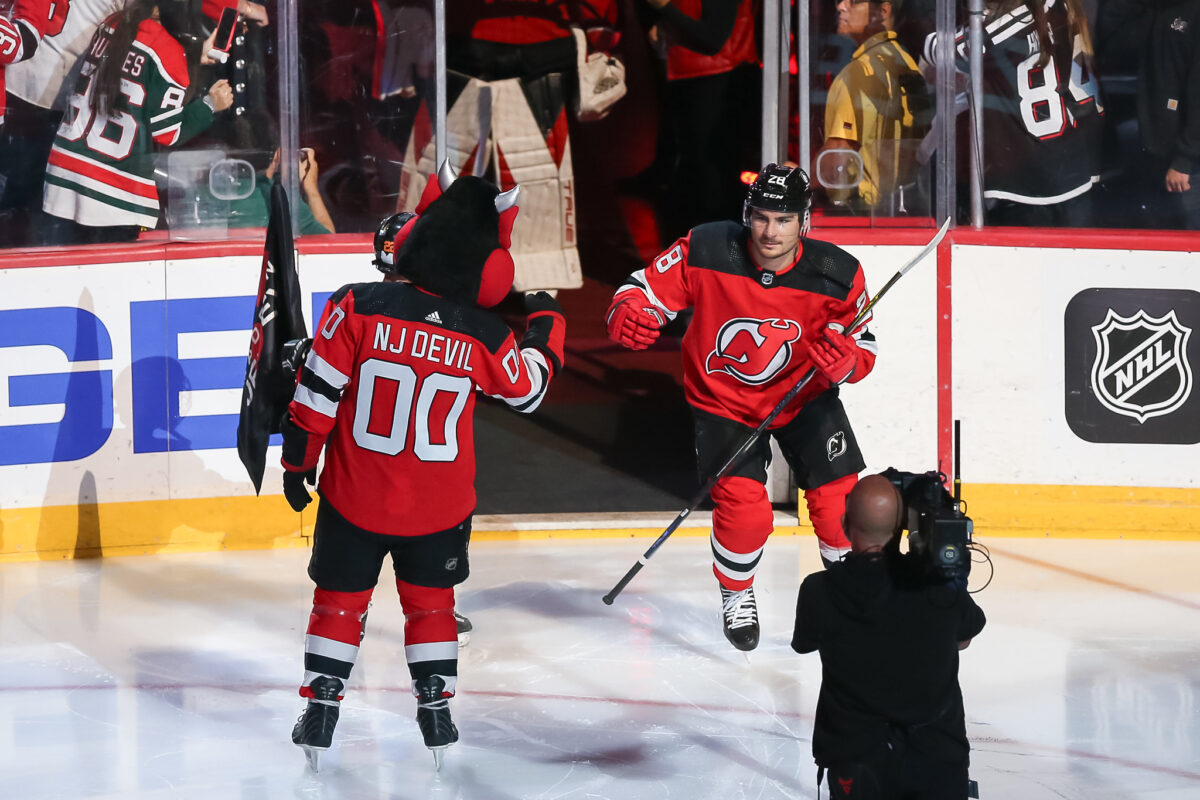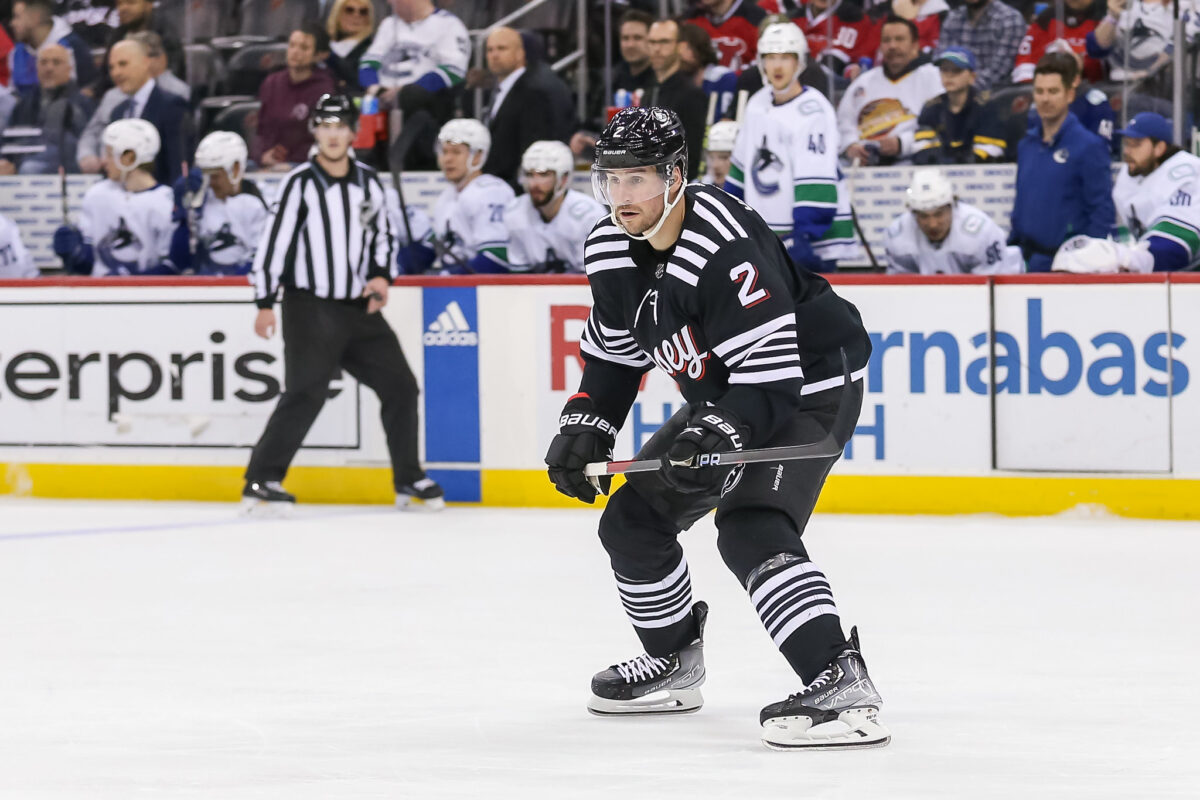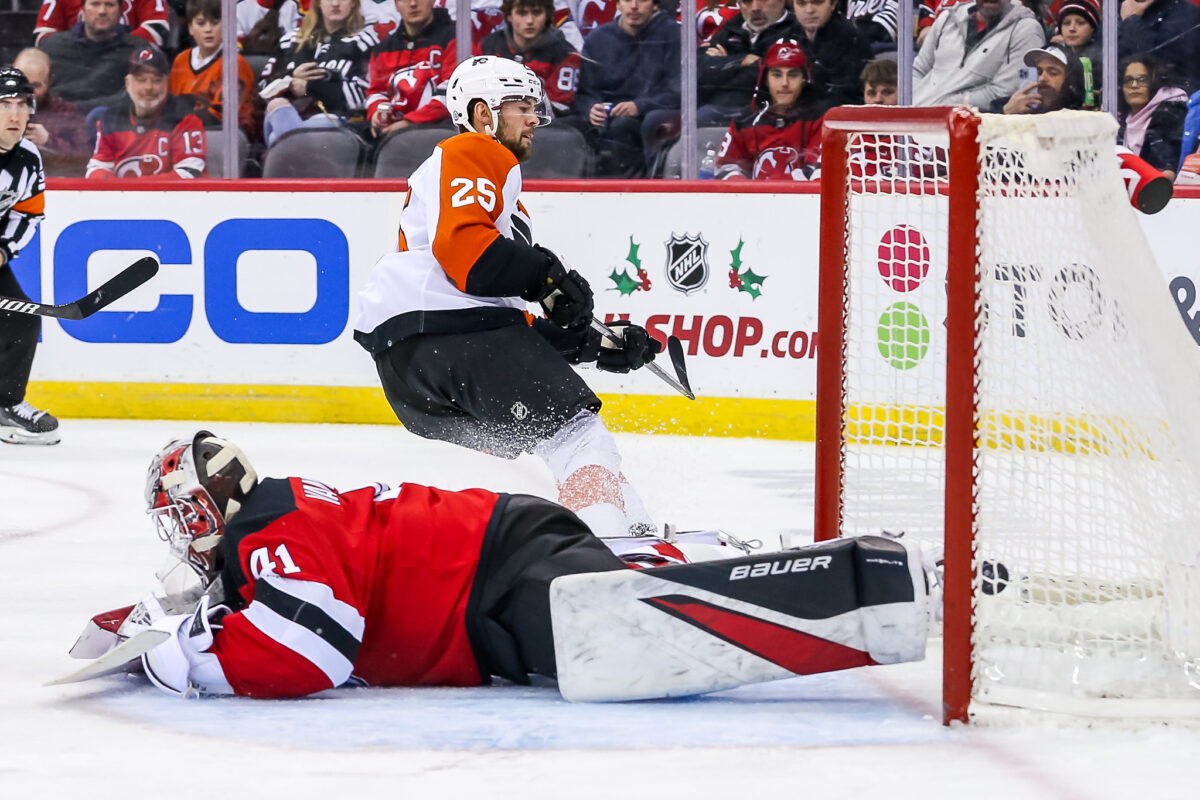It is not often that one comes into a pile of money, even less often when it happens the week before Christmas, but that is the situation the New Jersey Devils presently find themselves, and how they navigate this windfall will go a long way toward determining if they will still be playing when Dougie Hamilton is healthy enough to return. Losing a player the caliber of Hamilton is never ideal. Still, if there are any positives to be found, it has been the rise of Simon Nemec in his first exposure to the NHL and the ability to stash Hamilton on long-term injured reserve (LTIR) to allow them to use his cap charge to sign other players.
Flat Cap Relief
In a league with a hard salary cap that has not risen substantially in the last four years, almost all teams in contention for the Stanley Cup are fully leveraged and up against the cap. In the past year, several teams have had to play games with less than a full roster and participate in other shenanigans not to exceed the salary cap. Until last season, the Devils had not been one of those teams, but general manager Tom Fitzgerald convinced ownership that as the team succeeded it was time to spend to the cap and reward the surging team with reinforcements. After management agreed, Fitzgerald added Timo Meier and Curtis Lazar at the 2023 Trade Deadline and later signed Meier and Jesper Bratt to expensive contract extensions, solidifying the young core of the team for the next five years.

Cap space was not a major issue for the Devils this summer and heading into training camp as their major players were all locked up long-term, and the cap is set to rise by $4 or $5 million next season, with only Dawson Mercer and Michael McLeod needing new contracts. The presumed infusion of players like Alexander Holtz, Luke Hughes, and Nemec still playing on their entry-level contracts (ELC) gave Fitzgerald room to make significant commitments to his veterans while having cap space left to use in an emergency. In a league with so many cap-strapped teams, the Devils were prepared to use their position as a weapon.
RELATED: Tom Fitzgerald at an Inflection Point in His Devils Tenure
During the summer, Fitzgerald indicated that his management team had a number in mind of how much salary cap space they needed to begin the season to have a sufficient amount of accrued cap space to use, if needed, by the trade deadline (he declined to reveal the exact starting or ending number). With a rash of injuries hitting the team in the early going, the call-ups ate into his cap room, but the injury to Hamilton changed everything. With reports that he is likely out for the remainder of the regular season, he is a prime candidate to be placed on LTIR, which would allow the Devils to spend above the salary cap, up to the amount of Hamilton’s salary less the amount of cap space the team has when he is placed on LTIR. Often teams will seek to make a flurry of paper moves to diminish their cap space before placing a player on LTIR to maximize the benefit, which may explain the delay in putting Hamilton on the list.
Assessing the Team’s Needs
Many projected the Devils as one of the leading contenders for the Stanley Cup as the season began. For a myriad of reasons, the team has not yet risen to those expectations and is in a dogfight even to secure a spot in the playoffs. Fitzgerald has previously said that it would take 20-25 games to accurately assess his team, and the Devils just finished their 30th game. While more than a third of those games were without Nico Hischier and several without Jack Hughes, the general manager has to have a pretty good feel for what his team lacks. While the offense took a huge dip during the absence of the two centers, it is not a long-term concern when you have Hischier, Hughes, Jesper Bratt, Tyler Toffoli, and Meier. The decision then comes down to defense, goaltending, or both.
Goaltending
Ever since Vitek Vanecek struggled mightily in the 2023 Playoffs, many have written him off as having a ceiling of a tandem goalie – one that can play to league average numbers or slightly above, but not a player you feel confident can win you multiple playoff series. Akira Schmid is the opposite, he showed nerves of steel in the playoffs last season, shutting out the New York Rangers in Games 5 and 7, after they had put up ten goals on Vanecek in Games 1 and 2. Schmid is still young and raw, only three years removed from the ECHL and with only 38 games played, he is far from a finished product. Reports this summer indicated that the Devils considered sending him to the AHL to get more game experience, but that plan was scuttled when they didn’t add another goalie before camp.

Neither the standard goalie statistics nor the advanced metrics paint a pretty picture of the Devils goaltenders. For goaltenders who have played at least ten games, Schmid ranks 39th (minus-2.6) and Vanecek 54th (minus-6.5) in goals saved above expected. As a group, they are 28th in the NHL in that category. While defensive breakdowns have certainly occurred and led to grade-A chances for opponents, rare is the occasion where a Devils goalie has “stolen” a game. The stat that best quantifies making saves that can change momentum is high-danger save percentage (HDSV%). Of goalies who have played at least 500 minutes this season, Schmid ranks 30th in HDSV% while Vanecek is 56th, of 57. Earlier in the season, the Devils were able to outscore some of these issues, but as the season unfolds and the games get tighter those numbers are impossible to overcome and have to have an impact on a team’s psyche.
Defensemen
Losing around 900 NHL games on defense with the departures of Damon Severson and Ryan Graves was always going to be an issue for New Jersey in the early going of the season. The team was hopeful that Luke Hughes’ playoff success wasn’t a fluke and that he could be eased into the NHL playing alongside Colin Miller or Brendan Smith on the third pair. The plan to replace Graves was hoping that Kevin Bahl would continue to show improvement in his second full season and be able to eat up the valuable shutdown minutes that the Graves and John Marino pair were so effective at in 2022-23. The Devils had to also figure that they would take a hit on the PK with the loss of two penalty killers but likely believed Bahl could step in and that Miller or Smith would allow them to have two stellar pairs. While Smith’s contribution on the penalty kill kept him in the lineup when he was faltering in other areas, none of his teammates have stepped forward.

Whether to add a defenseman is a tougher call than it looks. The Devils currently have seven NHL-caliber defensemen, and with the emergence of Nemec, there is no room for another defenseman without removing one from the roster unless you sign a pending free agent, as Hamilton will be back next season. With that in mind, what the Devils need and who gets replaced has to be the question on Fitzgerald’s mind, which is complicated by having a stable of two of the best under-20 defensemen in the world who will only get better the more they play. The number of times both units of the league’s top power play have been run by rookies has to be single digits if any. The main needs are mobile, puck-moving, positionally sound players who excel on the penalty kill.
Go Get ’em
The Devils front office deserves the benefit of the doubt in identifying players who best fit their style of play and culture then going out and getting those players without mortgaging the future. That’s not to say they haven’t had to give up assets to get good players; look at the success of Yegor Sharangovich and Fabian Zetterlund on their new teams. Each struggled to acclimate to the Devils’ system and were turned into more sure things, Toffoli and Meier. An underrated skill of front offices is identifying who is not fit from within and moving them before their value is diminished. With that in mind, there are three types of players the Devils should target: a top goaltender with a track record, a defense-first defenseman in his walk year, and/or a defense-first defenseman who fits their timeline, style, and cap future. Here’s a look at each profile and potential fits.
Goaltender with Playoff Success
The Devils proved last season that they could win in the playoffs with the talent and style on their roster. They spent the offseason supplementing the core by adding Toffoli, Tomas Nosek, and Colin Miller. The one area of the team Fitzgerald chose not to touch was the goaltending. The Devils have paid in wins for that decision. Now, with the move of Hamilton to LTIR, Fitzgerald will have a second bite at the apple. This will arguably be his most important move since signing Jack Hughes to the most team-friendly contract in the NHL.
With the way New Jersey plays, they should be looking for an eraser, a goalie who can be counted on to wipe out mistakes and make big saves while stealing games. With two rookie defensemen each eating up more than 20 minutes of ice time per game, there are bound to be mistakes in communication and coverage, leading to high-danger opportunities. The Devils need a goalie that can be counted on to counter those chances. They also need a goalie with proven playoff success. Not necessarily a Cup winner but someone who the team is confident deploying in the playoffs along with Schmid and has the pedigree to carry a team through a round.

Three goalies that fit the profile of HDSV% success, playoff track records, and reasonable terms are Juuse Saros, Elvis Merzlikins, and John Gibson. With the caveat that the Devils need not ask the trading team to retain salary in exchange for taking Vanecek, they could easily fit any of the three under the cap, and each would be an immediate upgrade. All three have been rumored to be both on the move or completely unavailable, depending on when and who is reporting.
Saros is an annual Vezina Trophy candidate with all the measurables; the stat to ruminate on is his career playoff numbers of .914 save percentage (SV%) and 2.63 goals-against average (GAA). Merzlikins is having a career resurgence following a rough season in the wake of an enormous personal tragedy. He has ten quality starts this season while posting a .909 SV% and a .825 HDSV%. Devils fans saw Gibson in fine form on Sunday (Dec. 17), and in 26 career playoff games has posted a .926 SV% and a 2.80 GAA.
A trade for any of these players would likely include Vanecek, second or third-round picks, and a player on or near the NHL roster like Nolan Foote, Graeme Clarke, or perhaps Arseni Gritsyuk. All three of these teams are familiar with the Devils and would certainly have prospects they favor, but as long as the Devils aren’t married to only one player, the move should not be cost-prohibitive.
Veteran Defender UFA
The profile here is a player who is a known quantity. A defenseman who is a capable puck mover, skates well enough for Ruff’s system, yet is positionally sound and a top-level penalty killer. In one sense, they already have that player in Brendan Smith, but with the extra LTIR money, now is the time to upgrade and solidify the defense by creating a more competitive unit. Early in the season, with Miller out injured, the Devils had no viable replacements on the NHL roster and were forced to play the same six defensemen. Bringing in other players will only make the unit more competitive and give the team more choices and the ability to match up better against certain teams.
There are probably many potential players that could fit this profile. The one getting the most attention is Chris Tanev of the Calgary Flames. Tanev is rumored to be sought after by several teams, which could drive up his cost. His teammate Nikita Zadorov was traded earlier this season to the Vancouver Canucks and only commanded a third and a fifth-round draft pick. Tanev brings physicality, poise, and penalty killing and is a tenacious shot blocker. Other players that could be available as pending free agents, though not the defensive players that Tanev is, are Noah Hanifan and Tyson Barrie. Two players more in the Tanev-mold who could be available are Ilya Lyubushkin from the Anaheim Ducks and Erik Johnson of the Buffalo Sabres.
Defenseman With Term
The other option is to try to find a player who fits the Devils’ system better than some of their current players but, for whatever reason, is not a fit for their current team. Usually, the player is aged out of the window or is a remnant of a prior regime. With the hope that a change of scenery can return the player to his prior form, this category has the opportunity to have the most long-term reward, but it carries significant risk.
The Devils have strong connections to the San Jose Sharks front office. Last season, they pulled off the blockbuster move of the trade deadline when the Devils acquired Meier after months of negotiation. Now, the teams could find common ground on Mario Ferraro, the talented two-way defenseman. Ferraro is only 25 and is signed for another two years at a manageable cost. He wears an A for the Sharks and is third in the NHL in blocked shots. Ferarro’s game fits well with New Jersey’s style; the issue would be compensation. To make room on the roster, the Devils would likely have to part with an NHL defenseman, ideally Bahl, as well as some draft picks and maybe an American Hockey League (AHL) forward like Nolan Foote or Graeme Clarke.
The Devils now have options and a competitive advantage due to the Hamilton injury and the space created by placing him on LTIR. Fitzgerald should use that space to find the goalie the team needs to be successful in the postseason and find a way to upgrade the blue line, either with a short-term fix or a player with term. They could even do all three moves and still have enough to use at the trade deadline should another need arise or a veteran forward become available.
